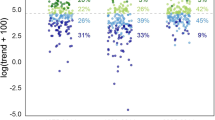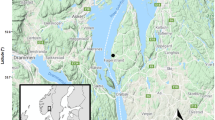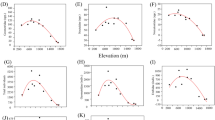Abstract
Moths make up a significant part of the biodiversity both in northwestern Europe and globally. In the Netherlands for instance, 766 species of larger moths are considered native. The interest of amateur recorders in this group in the Netherlands is rapidly growing. This has led to a strong increase in the number of records in the central database, allowing better and more precise calculations on the local trends of moths. About one-third of the species in our analysis are decreasing and could be listed as threatened. On the other hand, some species are strongly increasing. All species together show a significant, declining, trend in abundance. At the same time there exist strong year to year fluctuations in this trend which are due to weather conditions. We conclude, therefore, that the changing climate is having a strong impact on our moth fauna. The absolute number of individuals of the common species has dropped by one-third. We argue that this had a negative impact on plant biodiversity. The need for better protection of moths in northwestern Europe is also implicated by the fact that many species of birds, bats and other groups depend on moths (or their larvae) as main food sources.







Similar content being viewed by others
References
Bernays EA, Singer MS, Rodrigues D (2004) Foraging in nature: foraging efficiency and attentiveness in caterpillars with different diet breadths. Ecol Entomol 29:389–397
Boggs CL (1987) Ecology of nectar and pollen feeding in Lepidoptera. In: Slansky F, Rodriguez JG (eds) Nutritional ecology of insects, mites, spiders, related invertebrates. Wiley, New York, pp 369–391
Brown VK, Jepsen M, Gibson CWD (1988) Insect herbivory: effects on early old field succession demonstrated by chemical exclusion methods. Oikos 52:293–302
Chamberlain DE, Fuller RJ, Bunce RGH, Duckworth JC, Shrubb M (2000) Changes in the abundance of farmland birds in relation to the timing of agricultural intensification in England and Wales. J Appl Ecol 37:771–788
Conrad KF, Woiwod IP, Parsons M, Fox R, Warren M (2004) Long-term population trends in widespread British moths. J Insect Conserv 8:119–136
Conrad KF, Warren M, Fox R, Parsons M, Woiwod IP (2006) Rapid declines of common, widespread British moths provide evidence of an insect biodiversity crisis. Biol Conserv 132:279–291
Crawley MJ (1989) Insect herbivores and plant population dynamics. Ann Rev Entomol 34:531–564
Fox R, Conrad KF, Parsons MS, Warren MS, Woiwod IP (2006) The state of Britain’s larger moths. Butterfly Conservation and Rothamsted Research, Wareham, Dorset
Gilbert OL (1992) Lichen reinvasion with declining air pollution. In: Bates JW, Farmer AM (eds) Bryophytes and Lichens in a changing environment. Clarendon Press, Oxford, pp 159–177
Groenendijk D, van der Meulen J (2004) Conservation of moths in the Netherlands: population trends, distribution patterns and monitoring techniques of day-flying moths. J Insect Conserv 8:109–118
Hogstad O (2005) Numerical and functional responses of breeding passerine species to mass occurrence of geometrid caterpillars in a subalpine birch forest: a 30-year study. Ibis 147:77–91
Maron JL, Crone E (2006) Herbivory: effects on plant abundance, distribution and population growth. Proc R Soc B 273:2575–2584
Olf H, Ritchie ME (1998) Effects of herbivores on grassland plant diversity. TREE 13:261–265
Scherber C, Milcu A, Partsch A, Scheu S, Weisser WW (2006) The effects of plant diversity and insect herbivory on performance of individual plant species in experimental grassland. J Ecol 94:921–931
Schlegel R (1994) Der ziegenmelker. Die Neue Brehm-Bücherei, Westarp Wissenschaften
Schowalter TD (1981) Insect herbivore relationship to the state of the host plant: biotic regulation of ecosystem nutrient cycling through ecological succession. Oikos 37:126–130
Sierro A, Arlettaz R, Naef-Danzer B, Strebel S, Zbinden N (2001) Habitat use and foraging ecology of the nightjar (Caprimulgus europaeus) in the Swiss Alps: towards a conservation scheme. Biol Conserv 98:325–331
Tamis W, van ‘t ZelfdeM, van der Meijden R, Udo de Haes HA (2005) Changes in vascular plant biodiversity in the Netherlands in the 20th century explained by their climatic and other environmental characteristics. Clim Change 72:37–56
Telfer MG, Preston CD, Rothery P (2002) A general method for measuring relative change in range size from biological atlas data. Biol Conserv 107:99–107
Tilman D (1987) Secondary succession and the pattern of plant dominance along experimental nitrogen gradients. Ecol Monogr 57:189–214
Török J, Hegyi G, Tóth L, Könczey R (2004) Unpredictable food supply modifies costs of reproduction and hampers individual optimization. Oecologia 141:432–443
Vaughan N (1997) The diets of British bats (Chiroptera). Mammal Rev 27:77–94
Visser ME, Holleman LJM, Gienapp P (2006) Shifts in caterpillar biomass phenology due to climate change and its impact on the breeding biology of an insectivorous bird. Oecologia 147:164–172
Waring P, Townsend M (2003) Field Guide to the Moths of Great Britain and Ireland. Br Wildl Publ, Hook
Woiwod IP, Harrington R (1994) Flying in the face of change: the Rothamsted Insect Survey. In: Leigh R, Johnston A (eds) Long-term experiments in agricultural and ecological sciences. CAB International, UK, pp 321–342
Young M (1997) The natural history of moths. T & AD Poyser, London
Acknowledgments
We are grateful to all observers who have entered their moth records to the Noctua database, making this study possible. In addition, two anonymous reviewers and Dr. Martin Warren are acknowledged for their time and efforts to improve the manuscript.
Author information
Authors and Affiliations
Corresponding author
Rights and permissions
About this article
Cite this article
Groenendijk, D., Ellis, W.N. The state of the Dutch larger moth fauna. J Insect Conserv 15, 95–101 (2011). https://doi.org/10.1007/s10841-010-9326-y
Received:
Accepted:
Published:
Issue Date:
DOI: https://doi.org/10.1007/s10841-010-9326-y




